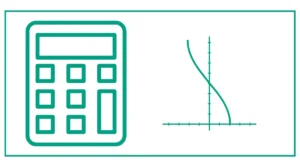The Secant calculator helps you calculate the secant of an angle. You can switch between degrees and radians.
Simply enter the value of Angle α and choose between degrees and radians to find the sec(α).
Secant is the ratio of the hypotenuse to the shorter side adjacent to an acute angle in a right-angled triangle in trigonometry. Secant is cosine’s reciprocal.
The secant formula is:
sec(α) =hypotenuse/adjacent=c/b
You might also want to determine the triangular pyramid or hemisphere volume.
What is the Secant Function?
The secant function is defined as the reciprocal of the cosine function. In mathematical notation, it is expressed as:
sec(θ) = 1 / cos(θ)
Where θ (theta) represents the angle in either radians or degrees. The secant function relates to a right triangle, where it represents the ratio of the hypotenuse to the adjacent side.
Understanding the Secant Calculator
Our secant calculator is a user-friendly tool that allows you to input an angle and instantly calculate its secant value. Here’s a breakdown of how to use the calculator effectively:
- Input: Enter the angle value in the provided field.
- Units: Select whether your input is in degrees or radians.
- Calculate: Click the “Calculate sec(α)” button to find the secant.
- Output: The calculator will display the secant of the given value.
How to Use the Secant Calculator
Using this calculator is straightforward. Follow these steps to find the secant of any angle:
- Enter the angle: Type the numerical value of the angle in the “Angle α” input field.
- Choose the units: Select either “Degrees” or “Radians” from the dropdown menu.
- Calculate: Click the “Calculate sec(α)” button.
- View the result: The secant value will be displayed below the button.
Examples Using the Secant Calculator
Let’s walk through two examples to illustrate how to use the calculator effectively.
Example 1: Finding the Secant of 45 Degrees
- Enter “45” in the angle input field.
- Select “Degrees” from the units dropdown.
- Click “Calculate sec(α)”.
- The calculator will display: sec(α): 1.41421356
This result means that the secant of 45 degrees is approximately 1.4142, which is equal to √2.
Example 2: Finding the Secant of π/4 Radians
- Enter “0.7853981634” (which is approximately π/4) in the angle input field.
- Select “Radians” from the units dropdown.
- Click “Calculate sec(α)”.
- The calculator will display: sec(α): 1.41421356
Notice that this result is the same as in Example 1. This is because 45 degrees is equal to π/4 radians, demonstrating the relationship between degrees and radians in trigonometry.
Applications of the Secant Function
Understanding and being able to calculate the secant function is valuable in various fields:
- Mathematics: The secant function is used in calculus, particularly in integration and differentiation of trigonometric functions.
- Physics: It’s applied in optics and wave theory, helping describe the behavior of light and sound.
- Engineering: Secant calculations are used in structural engineering for analyzing forces in trusses and beams.
- Computer Graphics: The function helps in rendering 3D objects and creating realistic animations.
- Navigation: Secant is used in celestial navigation and GPS systems for accurate positioning.
The Inverse Secant Function
While our calculator focuses on the secant function, it’s worth mentioning its inverse, the arcsecant (often written as sec⁻¹ or arcsec). The inverse secant function does the opposite of the secant function – it takes a number and returns the angle that would produce that secant value.
Secant in Relation to Other Trigonometric Functions
The secant function is closely related to other trigonometric functions:
- Secant is the reciprocal of cosine: sec(θ) = 1 / cos(θ)
- Secant squared minus 1 equals tangent squared: sec²(θ) – 1 = tan²(θ)
- The derivative of tangent is secant squared: d/dθ [tan(θ)] = sec²(θ)
These relationships make the secant function an essential part of trigonometric identities and calculus operations.
Common Mistakes When Using a Secant Calculator
When using a secant calculator, be aware of these common pitfalls:
- Unit confusion: Always ensure you’ve selected the correct units (degrees or radians) for your input.
- Domain errors: Remember that secant is undefined for angles where cosine equals zero (90°, 270°, etc.).
- Rounding errors: For precise calculations, use as many decimal places as your calculator allows.
The Secant Method in Numerical Analysis
While not directly related to our calculator, it’s worth noting that there’s a numerical technique called the “secant method” used for finding roots of equations. This method is an alternative to Newton’s method and doesn’t require the computation of derivatives.
Graphing the Secant Function
Understanding the graph of the secant function can provide valuable insights:
- The secant function is periodic, with a period of 2π radians or 360 degrees.
- It has vertical asymptotes at x = π/2 + nπ, where n is any integer.
- The function oscillates between these asymptotes, never taking values between -1 and 1.
References
- Reciprocal trig ratios (article) | Khan Academy. (n.d.). Khan Academy. khanacademy.org/math/trigonometry/trigonometry-right-triangles/reciprocal-trig-ratios/a/reciprocal-trig-ratios
- Expert Maths Tutoring in the UK – Boost Your Scores with Cuemath. (n.d.). Cuemath. cuemath.com/trigonometry/secant-function/





